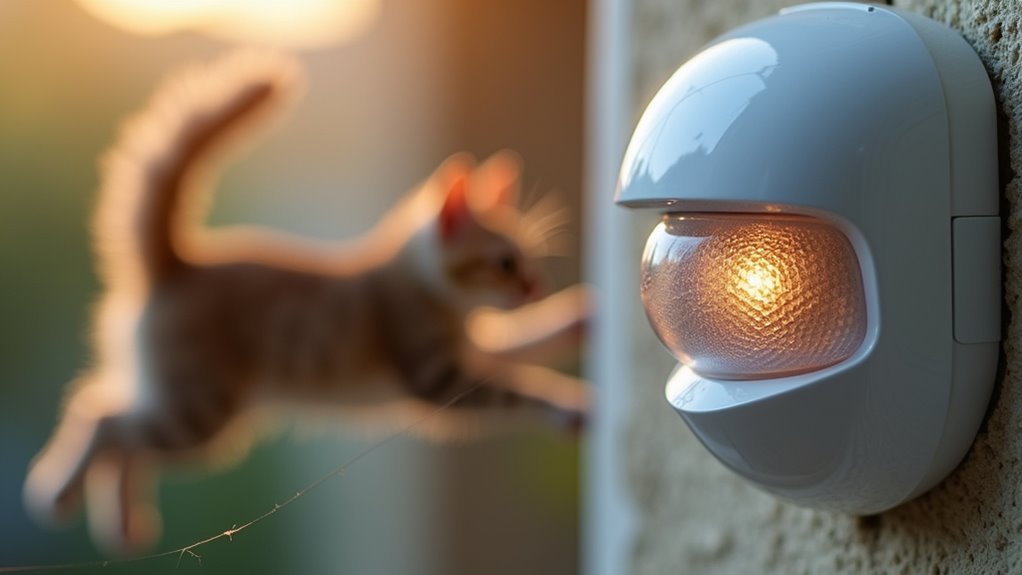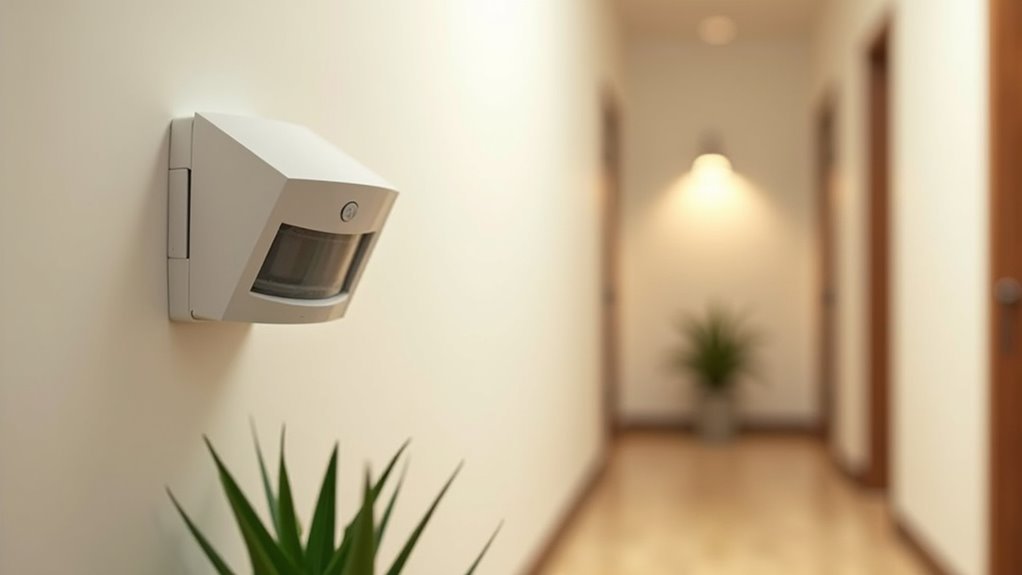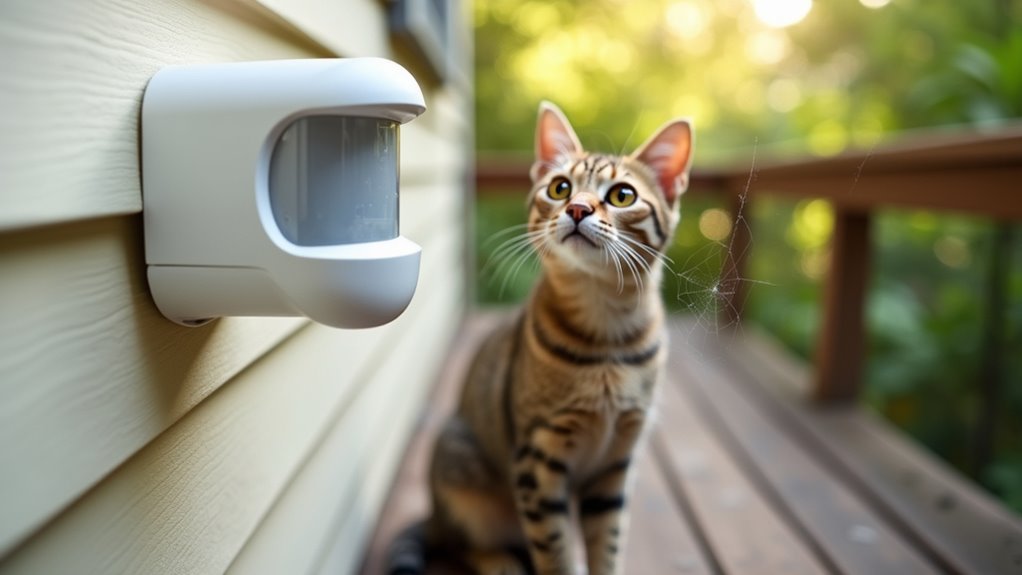You’ve probably experienced that frustrating moment when your motion sensor triggers an alarm at 3 AM, only to discover it was your cat walking by or a shadow from passing headlights. These false alarms aren’t just annoying—they can desensitize you to real threats and strain your relationship with neighbors. The good news is that most false alarms stem from preventable causes, and with the right adjustments and techniques, you can eliminate them completely.
Understanding How Motion Sensors Work and Common Triggers

When you’re dealing with frequent false alarms from your motion sensors, understanding how these devices actually work becomes essential for solving the problem. Your motion sensors detect movement by monitoring infrared heat signatures in their environment. When temperature differences occur within their detection range, they interpret this as potential movement and activate.
Several common factors trigger false alarms in your system. Direct sunlight streaming through windows creates sudden temperature fluctuations that confuse your sensors. Heating and cooling vents produce air currents with temperature variations that mimic human movement.
Your indoor pets moving within detection zones will activate sensors since they emit body heat. Weather changes, high humidity, dust buildup, and reflective surfaces also interfere with sensor accuracy, causing unnecessary alerts.
Proper Sensor Placement to Avoid Environmental Interference
You’ll prevent most false alarms by keeping your motion sensors away from windows where direct sunlight can create heat changes that mimic human movement.
Position sensors at least several feet from heating vents, air conditioning units, and other heat sources that cause temperature fluctuations.
These environmental factors are the leading culprits behind unnecessary alerts, so proper placement is your first line of defense.
Avoid Direct Sunlight
Direct sunlight creates one of the most common causes of motion sensor false alarms, as infrared sensors detect the heat variations caused by sunbeams streaming through windows and moving across surfaces.
You’ll want to position your sensors away from windows, especially those facing east or west where morning and evening sun creates the most dramatic temperature changes. Moving shadows from trees, clouds, or outdoor objects can trigger your system when direct sunlight shifts throughout the day.
Install sensors in corners facing inward rather than toward windows. This strategic placement reduces exposure to external light sources while maintaining coverage of your room.
If you can’t avoid window proximity entirely, consider using curtains or blinds to diffuse harsh sunlight during peak hours when false alarms occur most frequently.
Distance From Heat Sources
Heat sources create another major trigger for motion sensor false alarms, as HVAC vents, radiators, and appliances generate temperature fluctuations that infrared sensors mistake for movement.
Maintaining proper distance from heat sources is essential for preventing false alarms and ensuring reliable detection. Position your sensors at least 3-5 feet away from heating vents and air conditioning units. This distance prevents sudden temperature changes from triggering unwanted alerts.
You’ll also want to avoid areas where airflow from vents might alter heat patterns, as this confuses the sensor’s detection capabilities.
Install sensors between 4-5 feet high to minimize heat source interference while maintaining effective human movement detection.
Strategic placement in corners or inward-facing areas further reduces environmental interference from nearby appliances or heating systems.
Adjusting Sensitivity Settings for Your Home Environment

When motion sensors trigger repeatedly without cause, adjusting their sensitivity settings often provides the most effective solution for your specific home environment. Most sensors offer multiple sensitivity options, letting you customize responses based on household dynamics like pets or environmental factors such as direct sunlight and heating vents.
| Environment Type | Recommended Sensitivity | Reason | Testing Period |
|---|---|---|---|
| Homes with pets | Low to medium | Reduces false motion triggers | 1-2 weeks |
| High sunlight areas | Low | Minimizes light interference | 3-5 days |
| Near heating vents | Low to medium | Prevents heat-induced alarms | 1 week |
| Standard environments | Medium to high | Maintains security effectiveness | 5-7 days |
Test different levels systematically, then monitor performance regularly to verify you’ve minimized false alarms without compromising genuine threat detection.
Pet-Resistant Motion Sensors and Weight Threshold Settings
Pet-resistant motion sensors solve one of the most common false alarm triggers by using weight thresholds that typically ignore animals under 40 pounds.
You’ll get better results with Gen 2 sensors since they use advanced heat signature algorithms to distinguish between humans and pets more accurately.
Proper placement at 4-5 feet high combined with regular sensitivity adjustments will maximize your sensor’s ability to catch intruders while keeping your furry friends from setting off unnecessary alerts.
Weight Threshold Specifications
Most pet-resistant motion sensors use a standard 40-pound weight threshold to distinguish between your pets and potential intruders. However, weight threshold specifications vary greatly between manufacturers, making it vital to review each model’s capabilities before purchase.
| Brand Type | Weight Limit | Accuracy Rate |
|---|---|---|
| Basic Models | 25-35 lbs | 85% |
| Standard Units | 40-50 lbs | 92% |
| Premium Systems | 60-80 lbs | 97% |
You’ll find that newer pet-resistant motion sensors incorporate advanced algorithms that better differentiate between human and animal movements. These sophisticated systems analyze movement patterns beyond just weight, considering factors like gait and speed. When selecting sensors, consider your pet’s weight, jumping ability, and climbing habits to guarantee peak performance and minimal false alarms.
Gen 2 Sensor Features
Gen 2 Motion Sensors represent a notable advancement in pet-resistant technology, building upon the weight threshold foundations established in earlier models.
These gen 2 sensor features specifically target Motion Sensor False alarms by incorporating advanced technology that differentiates between human and pet movements. You’ll find these sensors filter out pets under specific weight thresholds, considerably reducing unnecessary alerts.
You can adjust the weight threshold settings to match your household’s specific needs, whether you have cats, small dogs, or larger pets. Users consistently report considerably fewer false alarms compared to older models, thanks to improved accuracy and sensitivity adjustments.
For optimal performance, you should install these sensors at proper heights and away from reflective surfaces, ensuring they detect genuine threats while ignoring harmless pet movements.
Optimal Placement Strategies
When installing pet-resistant motion sensors, you’ll achieve excellent performance by positioning them at the correct height of 4-5 feet from the floor. This placement effectively detects human movement while preventing smaller pets from triggering false alarms.
Proper installation requires avoiding direct sunlight and heating vents, as these heat sources can mimic human signatures and cause unwanted activations. You should also review your sensors’ weight threshold settings, which typically filter out pets below 40 pounds.
Consider upgrading to dual-technology sensors that combine passive infrared with microwave detection for enhanced accuracy. These advanced units greatly reduce false alarms from pets and other non-threatening movements.
Finally, regularly adjust sensitivity settings to find the best performance balance between reliable intruder detection and minimizing false triggers.
Avoiding Direct Sunlight and Heat Source Interference
Direct sunlight and heat sources rank among the most common culprits behind motion sensor false alarms, as these environmental factors can mimic the thermal signatures that sensors are designed to detect.
Environmental factors like direct sunlight and heat sources frequently trigger motion sensor false alarms by mimicking human thermal signatures.
You’ll want to strategically position your motion sensors away from windows, particularly those facing east or west where direct sunlight penetrates strongest.
Heat sources like heating vents and air conditioning units create sudden temperature fluctuations that confuse your sensors, making them interpret these changes as movement.
To minimize interference:
- Position sensors at corner locations to reduce exposure to direct sunlight and environmental disturbances
- Maintain 4-5 feet installation height for ideal heat signature differentiation
- Keep sensors away from HVAC equipment and heating vents
Regular cleaning prevents dust accumulation that can obstruct sensor operation and cause misinterpretation of thermal changes.
Optimal Height and Angle Installation Guidelines

You’ll dramatically reduce false alarms by mounting your motion sensors at the correct height of 4 to 5 feet from the floor.
Angle them downward between 15 to 30 degrees to enhance detection while avoiding environmental triggers like shifting sunlight.
Mount sensors securely on walls away from furniture and decorations that could obstruct their view or cause vibration-related false readings.
Proper Sensor Height Placement
The most critical factor in preventing motion sensor false alarms lies in selecting the correct installation height. You’ll dramatically reduce the frequency of false alarms by positioning sensors between 4 to 5 feet from the ground, which creates proper insulation from pet movements while maintaining ideal human detection capabilities.
For enhanced coverage in larger spaces, consider these placement strategies:
- Mount sensors at 7 to 8 feet high in spacious rooms or outdoor areas for maximum detection range.
- Angle sensors downward slightly to capture movement across the monitored zone effectively.
- Position units in room corners to cover broader areas while minimizing external triggers.
You’ll achieve the best results by avoiding direct window or heating vent placement, which prevents temperature fluctuations and sunlight from triggering unwanted activations.
Angle Adjustment Techniques
Achieving proper sensor height provides the foundation, but fine-tuning the detection angle determines your system’s accuracy.
These angle adjustment techniques will minimize false alarms while maximizing detection coverage. Angle your sensors slightly downward to create ideal detection zones without exposing them to problematic heat sources. Direct sunlight and heating vents cause temperature fluctuations that trigger unwanted alerts.
Position sensors in room corners facing inward, which naturally reduces window exposure and environmental interference. Avoid installing sensors directly opposite mirrors, glass surfaces, or metallic objects that reflect infrared radiation back to the detector.
These reflective surfaces create phantom readings that confuse the system. After installation, regularly verify your sensor alignment remains accurate. Environmental changes, renovations, or vibrations can shift angles over time, compromising performance and reintroducing false alarm issues.
Wall Mounting Considerations
When mounting sensors on walls, proper height placement becomes your first line of defense against false alarms. Installing your motion detectors between 4 to 5 feet high guarantees they’ll catch human movement while ignoring your pets below. These wall mounting considerations directly impact your system’s reliability.
Position sensors at strategic angles between 30 to 45 degrees to maximize detection while avoiding environmental triggers:
- Orient sensors away from windows, especially east or west-facing ones that create disruptive sunlight patterns.
- Choose corner locations facing inward to minimize external interference from shadows and weather changes.
- Secure mounting brackets tightly to eliminate vibrations that reduce false activations.
You’ll dramatically reduce false alarms by following these height and angle guidelines, creating a more dependable security system that responds only to genuine threats.
Regular Maintenance and Cleaning Procedures
Since motion sensors accumulate dust, debris, and environmental contaminants over time, establishing consistent maintenance routines becomes critical for preventing false alarms.
Your regular upkeep should include wiping sensor lenses weekly with a soft, lint-free cloth to prevent dust obstruction. Implement monthly visual inspections to spot damage or misalignment issues that compromise accuracy.
Schedule quarterly deep cleaning procedures, removing all debris around sensor areas for maximum performance.
Don’t forget battery maintenance—replace wireless detector batteries routinely to avoid erratic behavior from low power. Keep your system’s software and firmware updated, as manufacturers regularly release improvements that address known false alarm triggers.
These simple maintenance steps dramatically reduce unwanted activations while ensuring your motion sensors operate at peak reliability and accuracy.
Battery Replacement and Power Management
You’ll notice specific warning signs when your motion sensor’s battery starts failing, including delayed responses, intermittent triggering, or dashboard notifications indicating low power levels.
Following proper replacement steps guarantees your sensor maintains consistent performance and prevents power-related false alarms.
Let’s examine how to recognize these warning signs and execute correct battery replacement procedures.
Low Battery Warning Signs
While motion sensors provide reliable security monitoring, their performance deteriorates as batteries weaken, creating telltale warning signs you shouldn’t ignore.
Recognizing these low battery warning signs early helps you reduce false alerts and maintain peak security coverage.
Watch for these critical indicators:
- Intermittent alerts or delayed response times – Your sensor struggles to activate consistently or takes longer than usual to trigger
- Complete activation failures – The motion sensor stops responding entirely to movement in its detection zone
- Battery life indicators on your security app – Dashboard warnings or control panel notifications showing declining power levels
Don’t wait until your sensor fails completely.
Monitor these warning signs regularly and keep high-quality replacement batteries on hand.
Proactive battery management prevents unexpected sensor failures and maintains reliable security monitoring throughout your property.
Proper Battery Replacement Steps
Replacing motion sensor batteries correctly prevents false alarms and guarantees your security system operates at peak efficiency.
First, turn off your sensor before starting the battery replacement process to avoid triggering accidental alarms. Use only high-quality batteries that match your manufacturer’s specifications for maximum effectiveness and longevity.
When installing new batteries, mark the replacement date directly on them or maintain a replacement log. This tracking system guarantees you’ll replace batteries before they drain completely and reduce false alarms caused by low power.
After completing the battery replacement, test your sensor thoroughly to confirm it’s functioning properly.
Adjust sensitivity settings if needed to further minimize false triggers and maintain reliable security coverage throughout your property.
Wireless Vs Wired Motion Sensor Reliability
When choosing between wireless and wired motion sensors, you’re fundamentally deciding between convenience and reliability. While wireless sensors offer installation flexibility, they’re more prone to triggering false alarms due to battery degradation and signal interference. Wired systems consistently outperform their wireless counterparts in maintaining stable functionality.
Here’s why wired sensors provide superior reliability:
- Lower latency communication guarantees faster response times with your security system
- Professional installation optimizes placement and reduces false alarm likelihood
- Stable performance in extreme temperatures and electromagnetic interference environments
Wireless sensors can suffer from connectivity issues that lead to unnecessary false alarms, especially when batteries weaken.
If you’re prioritizing long-term reliability over installation convenience, wired motion sensors deliver the consistent performance needed to minimize frustrating false alarms.
Dual-Technology Sensors for Enhanced Accuracy
Since single-technology sensors often struggle to distinguish between genuine threats and harmless environmental factors, dual-technology sensors offer a superior solution by combining passive infrared (PIR) and microwave detection methods.
You’ll find these systems dramatically improve accuracy by requiring both technologies to detect movement simultaneously before triggering alerts.
These dual-technology sensors reduce false alarms caused by pets, insects, or minor environmental changes that typically fool single-sensor systems. They maintain high sensitivity to human movement while filtering out non-threatening disturbances effectively.
Dual-technology sensors eliminate pet-triggered false alarms while maintaining optimal detection sensitivity for actual human intruders.
Modern dual-technology sensors adapt their sensitivity based on simultaneous signals from both detection methods, enhancing overall reliability.
You’ll experience fewer costly false alarms and greater confidence that alerts indicate actual security threats, making your investment worthwhile.
Creating Detection Zones to Minimize False Triggers
Beyond selecting the right sensor technology, you can further reduce false alarms by strategically configuring detection zones that target only the areas you actually want to monitor.
Modern motion sensors offer customizable detection areas that let you exclude problematic zones where pets roam or environmental factors cause unwanted triggers.
- Position sensors in corners or angle them toward walls to limit their field of view and reduce exposure to external disturbances like sunlight or moving shadows.
- Exclude high-traffic areas where pets frequently move or where environmental factors consistently cause false alerts.
- Use multiple sensors with targeted zones to enhance security coverage while preventing overlapping fields that increase false alarm likelihood.
Regularly review your detection zones and adjust them based on observed false alarm patterns to optimize sensor performance and effectiveness.
Upgrading to Newer Generation Motion Detectors
Although proper sensor placement helps reduce false alarms, older motion detectors often lack the sophisticated technology needed to eliminate them entirely.
Upgrading to Gen 2 Motion Sensors brings significant improvements through advanced pet-resistant technology that effectively differentiates between small animals and genuine intruders.
Newer detectors incorporate sophisticated algorithms that distinguish real threats from harmless environmental factors.
Many upgraded models feature dual-technology detection, combining passive infrared and microwave sensing for enhanced reliability and fewer false activations.
You’ll also benefit from adjustable sensitivity settings that let you customize detection ranges for your specific environment.
While upgrading requires initial investment, you’ll reduce false alarms long-term, saving money on costly service calls and potential fines from unnecessary emergency responses.
Testing and Calibrating Your Motion Sensor System
Even with upgraded motion sensors, you’ll need to test and calibrate your system regularly to maintain ideal performance and minimize false alarms.
Testing involves simulating movement throughout your space to verify accurate detection while calibrating means adjusting sensitivity settings based on your specific environment.
- Position sensors strategically at 4-5 feet height, away from windows and heating vents to minimize environmental interference that triggers unwanted alerts.
- Adjust sensitivity settings to lower levels if you have pets or small animals, reducing false triggers while maintaining security coverage.
- Perform routine maintenance by cleaning sensors regularly to eliminate dust buildup and using built-in testing features to observe system responses.
Proper testing and calibrating guarantees your motion detection system responds appropriately to genuine threats while ignoring harmless environmental factors.
Troubleshooting Persistent False Alarm Issues
When false alarms persist despite proper testing and calibration, you’ll need to dig deeper into systematic troubleshooting to identify the root causes.
Start by adjusting your motion sensor’s sensitivity settings – lower sensitivity effectively prevents pets and environmental factors from triggering unwanted alerts.
Check your sensor positioning, ensuring they’re away from direct sunlight, heating vents, and reflective surfaces that cause interference.
Clean your sensors regularly to remove dust accumulation and prevent insect interference that leads to movement misinterpretation.
Inspect wiring connections and battery levels, as these electrical issues commonly cause Sensor False Alarms.
If problems persist, consider upgrading to dual-technology sensors or newer pet-resistant models specifically designed for reducing false alarm occurrences through improved accuracy and advanced detection algorithms.
Frequently Asked Questions
Why Is My Motion Sensor Giving False Detections?
Your motion sensor’s giving false detections because it’s likely detecting environmental changes like sunlight, temperature shifts, or small pets. Poor placement near windows or vents also causes unnecessary triggers affecting accuracy.
Why Does My Motion Sensor Alarm Go off for No Reason?
Your motion sensor alarm triggers unnecessarily due to environmental factors like sunlight, temperature changes, pets, improper installation near heat sources, or dust buildup blocking proper operation and detection accuracy.
What Types of Sources May Cause False Alarms for PIRS?
You’ll encounter false alarms from direct sunlight, temperature changes, pets exceeding weight thresholds, airflow from vents, dust on sensor lenses, and improper placement near windows or reflective surfaces.
What Is the Main Cause of False Alarms?
Environmental factors cause most false alarms in your motion sensors. You’ll find direct sunlight, heat sources, and temperature changes from vents confuse sensors by creating thermal patterns that mimic human movement signatures.





Leave a Reply